As Plant-Based Fitness Advisor for the McDougall Health and Medical Center Discussion Boards, I have the honor and privilege of reaching thousands of people who are looking for a health-supportive, body-friendly, easily successful food plan that delivers every time with health, energy and weight loss where needed. The McDougall Maximum Weight Loss Plan is the quickstart pathway to get you going – here it is in a nutshell.
The McDougall Maximum Weight Loss Plan
John McDougall, M.D.
The McDougall Maximum Weight Loss (MWL) plan is for those who find they need or want to optimize for most rapid results. This doesn’t make it “better”, simply a strategy AND a good way to get things going when make the switch to starch, plants, low fat fat loss.
For those who don’t and are curious about content of the MWL book, here is a great overview and key points of this book. Keep in mind this is not the requirement for all McDougall style eating, just the barest to the bone of the principles for, well, MWL!
Pushing Your Set Point to the Limits
The McDougall Program for Maximum Weight Loss
The set point theory is rock solid – so accept the fact that you are stuck in your present body size and shape. Look around – don’t the body shapes of your friends and relatives remain about the same year after year? Mr. Jones, working behind the counter at the post office, has been rotund since the day you met him 20 years ago. Your Aunt Millie maintains her same full form – with a few fleeting changes due to one fad diet or another. With rare exceptions, the fat ones stay fat and the trim ones stay trim. Their identities (and yours) are maintained like the presidents’ faces carved in stone on Mount Rushmore.
Fortunately, there are ways out of this ambush.
You have three basic choices:
You could eat less everyday. But that doesn’t work because it hurts too much to be hungry all the time. Proving the accepted statement, “Diets Don’t Work.” |
||
|
|
You could start an intense exercise program. People become marathon or triathlon runners – losing weigh by dedicating 2 hours or more a day to strenuous exercise. And they keep the weight off as long as they are able to endure this brutal routine. Painful! |
|
|
|
Change the composition of your foods. Quickly learn to enjoy delicious healthy meals – no pain, all gain (I mean, weight loss). Last month’s newsletter discussed this basic concept in detail: Eat like an Asian (rice-based diet) – look like an Asian (trim, young and active). Otherwise, continue eating like an American, and continue to… |
From my viewpoint there is only one obvious choice in order to become trim and healthy for a lifetime. Hopefully, by now that is your viewpoint, too.
How Well Does the “Regular” McDougall Program Work?
We have collected weight loss data on nearly 300 people who have attended our basic McDougall Program in Santa Rosa, California and found that with unrestricted eating (buffet tables of delicious healthy foods, three meals a day, and snacks all day long), the average weight loss is a half a pound a day – 3.5 pounds in a week – translated into 14 pounds a month – and so on, until trim body weight is reached.
This is a highly desirable rate of weight loss. Most experts say you should set your weight loss goals at no more than 2 pounds a week. Don’t worry about the extra pound and a half weekly loss you get with our program. Three and a half pounds per week is not too fast because our recommendation is for you to change to a natural and normal behavior: to eat delicious foods to the full satisfaction of your healthy appetite. This intelligent lifestyle transformation results in weight loss that is permanent – a new you from new nutrition.
How Well Does the Maximum Weight Loss Program Work?
This past month (January 14 to 23, 2005) we held our first 10-day live-in program based upon the principles of Maximum Weight Loss – designed by Mary and John McDougall almost 20 years ago to help people lose weight faster and easier, and to maintain that new size. Thousands of people have successfully followed this program at home. Some implement the rules strictly, all of the time, and others simply use the more limiting program for short periods to lose a few stubborn pounds, returning to the “regular” McDougall Program for most of the year. (The most significant difference, as you will soon learn, is that the “regular” program uses whole grain flour products, like breads, bagels, and muffins, and more fruits, juices and other simple sugars.)
The average weight loss achieved in this first ever Maximum Weight Loss Live-in Program held at our clinic in Santa Rosa, California was slightly over 4.5 pounds in 7 days – in other words, about one pound more than is lost in the usual program for the week. (That’s 52 extra well-deserved pounds in a year from that extra effort.) Our guests never suffered a moment of hunger and they thoroughly enjoyed the tastes of the meals we served to them. That was obvious; they ate 2, 3, 4 and more servings at each meal. Most importantly, they loved the results – easy weight loss, relief of headaches and arthritis, and dramatic reductions in blood sugars, cholesterol, and triglyceride levels. They got their lives back – all by eating delicious foods.
Refinements for Maximum Weight Loss
Here Are the Measures Taken to Emphasize Weight Loss:
Thrive on Unrefined Starch:
Starches are low in calories (calorie dilute), low in fat (the fat you eat is the fat you wear) and high in carbohydrate (which satisfies the hunger drive). Most importantly, there are sufficient calories in starches to meet your needs for energy and to satisfy your powerful hunger drive. Some starches, like squash and potatoes, are lower in calories than others (like grains), and these are very good for rapid weight loss. Starches like beans, peas, and lentils slow the emptying of the stomach, keeping you feeling satisfied longer, and thereby encouraging lasting weight loss, and providing an emotionally rewarding dining experience.
Program Protocol: At the Maximum Weight Loss Program (at our clinic) we served at least one entrée every meal as a low-calorie unrefined starch. Popular dishes were Shepherd’s Pie (found in the April 2002 newsletter), Spicy Yam Stew (December 2004), Vegetable Bean Enchiladas (The Quick and Easy Cookbook) and Mexican Meal (June 2003).
Practical Tips for Home Compliance: You need to find one starch-based dish that you enjoy for each meal (this can be the same starch for every meal – like potatoes for breakfast, lunch, and dinner). If you fail to make this choice, and instead focus on mostly green and yellow vegetables, you will become ravenously hungry, out of control, and soon off your new nutritional program – and there you will be, fat again.
Don’t overlook this essential component of each meal because you may have heard some nonsense like “starches are fattening.” Remember that all successful populations living on healthy diets have had starchy plant foods as their main sources of calories (Japanese – rice, Peruvians – potatoes, Papua New Guinea Islanders – sweet potatoes, rural Mexicans – corn and beans, etc.) There are many unrefined starch dishes in all of our books and in the recipe section of each newsletter. You will find the “Quick and Easy Cookbook” especially supportive for those beginning the program – but all of more than 2000 published recipes from various sources are helpful.
Avoid Refined Foods and Flours:
Those interested in the utmost efficiency for weight loss should eat their starches in an unprocessed and unrefined condition. In practical terms, this means you minimize your intake of flour products. Flours are more rapidly absorbed than are the whole grains, causing a greater rise in insulin levels. The reason for this is that when you cut a kernel (corn) or a grain (wheat-berry) into a thousand pieces with the steel blade of a grinder; you dramatically increase the surface area for absorption through the intestinal wall – rapid, more complete absorption means more insulin produced. Insulin’s job is to push fat into fat cells (adipose tissue) where it is stored as the “metabolic dollar” for the day when no food is available – but for almost no one in Western societies does that ever occur.
Program Protocol: Except for a few offerings of whole corn tortillas, we eliminated all breads, pastas, bagels, and other flour products. This was an easy adjustment for program guests.
Why did we allow corn tortillas, and not bread and bagels? You can effortlessly eat a half a loaf of bread in one short sitting. That could be over 600 calories downed without a guilty thought – after all it is made of “all natural, whole wheat flour, without butter.” Two or three corn tortillas, at 50 calories each, are more than enough for most people to consume at one sitting.
Practical Tips for Home Compliance: Most of you will still easily lose weight and become healthy if you include some flour products – even whole grain breads – in your diet – but, don’t over-consume them. For best results, these processed foods should be kept for special occasions, and eliminated entirely if weight loss is difficult for you.
Eat Green and Yellow Vegetables:
Typically “popular diets” recommend that you eat large amounts of green and yellow vegetables, which are very low in calories, thus filling your stomach with low energy bulk (they are high in nutrients, however). I suggest about one-third of the meal should be from these low-calorie vegetables for accelerating weight loss. If you are desperate, then you may push that amount to one-half of your plate (measured roughly by your eye).
However, be careful that you do not eat so many of these low-calorie vegetable foods that your meals are no longer enjoyable and satisfying for your hunger drive. You need the starchy selections for sustaining satisfaction. No population of people has ever lived on a diet based on low-calorie green and yellow vegetables. All successful societies have centered their diets on starches (rice, potatoes, beans, corn, etc.) – and you must do the same for long-term victory.
Program Protocol: At our live-in program, the dining room serving tables look like this:
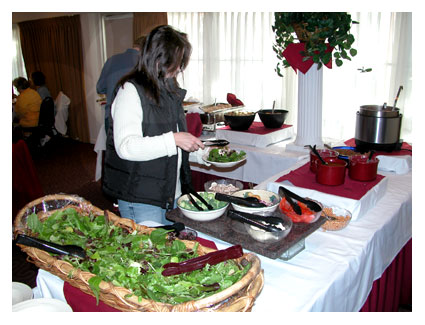
|
|
Begin with leafy green salads and bowl of shredded carrots, beets, celery, onions, and cabbage as options to top your salad. |
|
|
|
Then, choose any of 4 distinctly different flavorful, fat-free salad dressings which are set on the serving table. For example, Oriental, Berry Vinaigrette, and Tofu Island. (Find dressings in the August 2004 newsletter.) |
|
|
|
Next take generous helpings two raw vegetable salads, like fat-free Coleslaw, Tomato Vegetable Salad, and Spinach Salad. |
|
|
|
Then you come to two hot steamed green and/or yellow vegetable dishes are served, like seasoned steamed carrots, zucchini, kale, baby bok choy, or broccoli. Our guests were asked to eat full servings of these very low calorie dishes before moving on to the starches. |
|
|
|
At every lunch and dinner take a bowl full of delicious soup based on beans and/or vegetables. Popular examples included Black Bean, Broccoli, Sweet Potato, and White Bean. |
|
|
|
Finally, finish off your meal with the starchy entree (like Shepherd’s Pie, Mexican meal, or Stuffed Green Peppers) and you will find yourself fully satisfied until the next meal, (sometimes coming only 2 hours later as a hearty snack). |
Practical Tips for Home Compliance: Begin your main meals with a full bowl of mixed salad leaves and oil-free bottled dressing. Supermarkets and natural foods stores sell bags of washed lettuce leaves and a large variety of bottled, oil-free dressings. Make yourself a boiled or steamed vegetable dish, like carrots, broccoli, cauliflower, and/or peapods. Have your starchy entrée last.
Eat More Raw Foods:
 Raw vegetables are less digestible, providing fewer calories. Cooking begins the digestion process of foods and breaks complex carbohydrates into simpler (sweeter tasting) sugars – and more calories. Therefore, eat uncooked foods when you have the chance in order to accelerate weight loss.
Raw vegetables are less digestible, providing fewer calories. Cooking begins the digestion process of foods and breaks complex carbohydrates into simpler (sweeter tasting) sugars – and more calories. Therefore, eat uncooked foods when you have the chance in order to accelerate weight loss.
Program Protocol: During the Maximum Weight Loss Program a plentiful supply of green and yellow vegetables, like baby peppers, green peapods, small tomatoes, jicama, broccoli, and carrot sticks were served at the back of the lecture room. At mealtimes, the salad bar with lettuce leaves and a large variety of uncooked vegetable toppings were at the beginning of the serving line.
Practical Tips for Home Compliance: One easy way to have raw vegetables handy for snacking anytime at home is to slice up carrots, celery, green onions (scallions), bell peppers, and radishes, then put them in a bowl and cover them with water (change water daily). Keep them at eye-level on a shelf in the refrigerator so they will be easily available and always fresh.
Avoid All High-Fat Plant Foods:
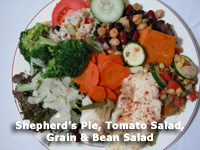 Nuts, seed, olives, avocados, and soy products (unless they are manufactured to be fat-free) are high in fat, which you will wear. Vegetable oils, like olive, corn, safflower, canola, and flaxseed oil are 100% fat that will be transferred effortlessly to your chin, buttocks, thighs, and abdomen. Avoid these as if they were poisons for your personal appearance.
Nuts, seed, olives, avocados, and soy products (unless they are manufactured to be fat-free) are high in fat, which you will wear. Vegetable oils, like olive, corn, safflower, canola, and flaxseed oil are 100% fat that will be transferred effortlessly to your chin, buttocks, thighs, and abdomen. Avoid these as if they were poisons for your personal appearance.
Program Protocol: These delicacies were not served to our guests during our Maximum Weight Loss Live-in Program.
Practical Tips for Home Compliance: When I was growing up, nuts were something you had for special occasions, like Christmas. These richer foods should be kept for holidays, and then, only after you have lost all of your unwanted body fat.
Avoid Sugar:
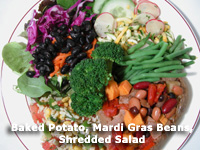 Minimize sugar intake. Sugar raises insulin levels, preventing fat from coming out of your fat cells. Simple sugar foods like table sugar (even brown sugar), maple syrup, molasses, and honey are also very concentrated with calories.
Minimize sugar intake. Sugar raises insulin levels, preventing fat from coming out of your fat cells. Simple sugar foods like table sugar (even brown sugar), maple syrup, molasses, and honey are also very concentrated with calories.
Program Protocol: For the Maximum Weight Loss Program, sugar was not used in the preparation of the foods (with a couple of exceptions). Sugar, honey, maple syrup or molasses were not available on the dining tables. A no-calorie, sugar alternative, Stevia, was placed on the table and enjoyed by some of our guests.
We serve foods containing simple sugars for the first meal and the last 2 meals. The first Friday evening meal was a little richer with a sugary dessert (brownies) to help some people make the transition more easily. Sugar in the last two meals was a little sweetener in a bean salad and maple syrup for our last pancake breakfast. Guests were shocked by how intense the sugars tasted at this last meal and this served as an education to show them how quickly their taste buds adapt. At all three of these meals, which included a sweetener, there were plenty of sugar-free options served, if our guests chose not to indulge.
Practical Tips for Home Compliance: Keep the refined sugars out of the house if you are an “addict.” I find some people deal with these sweeteners as if they were tobacco to a smoker, alcohol to a drunk, and heroin to a junkie. You know who you are, so act appropriately.
Minimize Fruits:
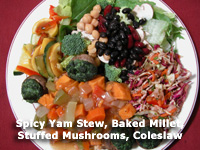 Keep fruits to one or two a day. Fruit is largely simple sugar and people can easily eat 10 to 20 servings a day without a guilty thought – after all, fruit is healthy. In truth, fruits should be thought of as healthy desserts, made largely of sugar and water (but with lots of wholesome nutrients). Vegetable juices (carrot, celery, tomato, etc.) are only slightly less detrimental to your weight loss than fruit juices. Dried fruits are even bigger “calorie bombs.” They are concentrated into a small volume by the dehydration processes, so you can eat 20 dried apples in the time it would take you to eat 2 whole fresh apples.
Keep fruits to one or two a day. Fruit is largely simple sugar and people can easily eat 10 to 20 servings a day without a guilty thought – after all, fruit is healthy. In truth, fruits should be thought of as healthy desserts, made largely of sugar and water (but with lots of wholesome nutrients). Vegetable juices (carrot, celery, tomato, etc.) are only slightly less detrimental to your weight loss than fruit juices. Dried fruits are even bigger “calorie bombs.” They are concentrated into a small volume by the dehydration processes, so you can eat 20 dried apples in the time it would take you to eat 2 whole fresh apples.
Program Protocol: During the “regular” McDougall Programs in Santa Rosa we serve a plentiful supply of fruits for snacks in our educational room. No dried fruits or juices are served.
The Maximum Weight Loss Program is much more restrictive. For snacks, fruits are replaced with green and yellow vegetables, like baby peppers, green peapods, tomatoes, jicima, and carrots.
Practical Tips for Home Compliance:
For maximum weight loss you should avoid all juices and dried fruits, and keep the fresh fruits to a minimum. Fill your refrigerator and bowls on your kitchen counter with vegetable treats like baby peppers, green peapods, jicima, broccoli, and/or carrot sticks. Readily available boiled potatoes are also helpful and very filling – make them even more inviting with your favorite oil-free dressing or salsa.
Eat Slowly and Frequently:
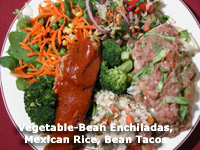 Eat many smaller meals (8 to 14 times a day), rather than a few large ones (1 to 3 a day). The advantages of frequent small meals are: (1) Less dependency on your body’s storage mechanisms (there is no reason to store food, because it is always available); (2) Lower total daily insulin production which occurs with small frequent meals (same number of calories). (3) Improved awareness. This is most important, because when you eat slowly and frequently, your brain and body have more time to receive the “I’m full” messages from your intestines that you have eaten. Gorging on a large meal generally means you will take in more food than you need long before your mind registers that you have eaten sufficient food to meet your needs.
Eat many smaller meals (8 to 14 times a day), rather than a few large ones (1 to 3 a day). The advantages of frequent small meals are: (1) Less dependency on your body’s storage mechanisms (there is no reason to store food, because it is always available); (2) Lower total daily insulin production which occurs with small frequent meals (same number of calories). (3) Improved awareness. This is most important, because when you eat slowly and frequently, your brain and body have more time to receive the “I’m full” messages from your intestines that you have eaten. Gorging on a large meal generally means you will take in more food than you need long before your mind registers that you have eaten sufficient food to meet your needs.
Program Protocol: Meal-times span a full hour each for breakfast, lunch and dinner during the live-in programs. At each table sat the most interesting people – stimulating conversations kept guests sitting for the entire hour – filling themselves with multiple platefuls of delicious foods. Our cooking class, taught by our dietitian and chef, was held mid-morning. Her samples provided a full meal about 10:30 AM daily. Snacks of boiled potatoes, and green and yellow vegetables were ever-present in the meeting room.
Practical Tips for Home Compliance: Divide all your meals into smaller portions. For example, eat a medium-sized plate of food, leave the table for half an hour, and if you are still hungry, return for another similarly-sized plate. Plan on many meals, and snacking throughout the day on healthy choices.
Keep Your Meals Simple (Monotonous):
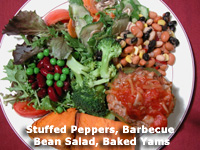 Variety causes you to eat more. So, if you like something, eat it over and over again. You don’t have to worry about adequate nutrition with a simple meal plan, as long as the foods you eat are unrefined and based around a starch with a fruit and/or green and yellow vegetable.
Variety causes you to eat more. So, if you like something, eat it over and over again. You don’t have to worry about adequate nutrition with a simple meal plan, as long as the foods you eat are unrefined and based around a starch with a fruit and/or green and yellow vegetable.
Program Protocol: We did not follow this advice at the program. At each lunch and dinner we had at least 10 choices of dishes that could make a satisfying meal. Our goal was to show people options – over 100 selections in 10 days. Guests were not expected to like everything we served – but most did.
They were instructed at the beginning of the 10 days that one of their goals for the program was to find one item they liked and were willing to fix for breakfast – like steel cut oat cereal or hash brown potatoes; one filling dish for lunch – like a baked potato with toppings, a plate of seasoned beans and rice or a hearty soup; and something for dinner – like the mashed potato-based dish, Shepherd’s Pie, or the Mexican Meal.
Practical Tips for Home Compliance:
Find three to nine dishes you have time to prepare daily and enjoy – and make these over and over again. Make large batches of these items – put some in the refrigerator and package some for the freezer. However, if monotony bores you, and instead, you like variety, we have over 2000 published recipes and a thousand of them fit the Maximum Weight Loss Program – so enjoy!
Lower Salt Intake:
Saltiness is a taste enjoyed naturally by sensitive buds on the tip of your tongue. We seek salt. As a result, saltiness of the foods increases the amount we consume. Eating can be driven by the desire for salt, rather than by real hunger.
Program Protocol: All dishes were made with no added salt, except for a very few that required soy sauce. People love salt, so we had salt shakers on every table – they could add this flavoring to the surface of their foods. In this manner they consumed much less salt then they would have if the salt had been added during cooking, and they missed nothing in terms of familiar taste (saltiness).
Practical Tips for Home Compliance: Learn to enjoy your foods with little or no added salt. Scientific research shows it takes about 7 to 14 days to make the adjustment to less saltiness. If you must use salt, then add it to the surface of the foods at the table, not during cooking.
It’s OK to be Hungry:
Sometimes you will find yourself in a situation where there is no healthy food available – like when you are out shopping, at a party, or dining with friends. You don’t have to eat. No harm will be done. You won’t starve to death by waiting a few hours until something healthy is available. Delaying gratification is the smart thing to do and when you do finally eat the right foods they will taste extra delicious.
Program Protocol: No one went hungry during the 10 days with us. One of the lessons of our program was successfully taught – “You can eat as much as you want of delicious foods and lose weight.”
Practical Tips for Home Compliance: After leaving the program, people will not have multiple-course meals served to them 3 times a day with snacks mid-morning and mid-afternoon – and thus, they are expected to lose even more briskly at home. If you get stuck with nothing healthy to eat, your best choice in most cases is to go hungry – when you finally do eat, the foods will be even more delicious than usual.
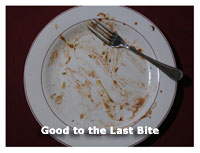
Exercise:
Exercise burns calories and causes you to take in more appropriate amounts of food – your appetite is regulated. Placing extra physical demands on your body will also send a message to your brain that you need to be trimmer in order to perform at the requested level. Your body will adjust to these new demands by becoming lighter and fitter, so that you will be able to run that mile and climb that mountain. Exercise before (rather than after) you eat to suppress your appetite even more.

Program Protocol: Each morning began with an optional 7 AM walk with our fitness instructor. Daily exercise classes – in the exercise room or in the heated pool were held at noon just before lunch. The afternoon exercise sessions included Yoga. Guests had access to the onsite athletic club with all of the most modern fitness equipment and professional trainers to help them with their routines.
Practical Tips for Home Compliance: Find an exercise you enjoy doing – walking, windsurfing, bicycling, etc. Join a local athletic club. On both of our programs you will lose excess weight even if you do not exercise, but you will not be as fit as you deserve without a daily routine that challenges your muscles.
Avoid Alcohol:
Alcohol provides calories. Alcohol lowers inhibitions so you “can’t just eat one.”
Program Protocol: No alcohol is served at the program – but that does not mean that a few people did not have their evening glass of wine when they returned to their private rooms.
Practical Tips for Home Compliance: You know if you have a problem with alcohol. If so, then life will go better for you after this problem is resolved.
Real Benefits of the Maximum Weight Loss Program
We are very pleased with the first Maximum Weight Loss Live-in 10-day Program. The weight loss was slightly greater than in the “regular” program, because the food choices were more restricted. However, this does not necessarily mean this presentation will ultimately be more successful. Success to me means long-term changes. Will this more restrictive training mean people are better able to permanently improve their lives? I believe so for several reasons:
| a | The weight loss program consistently provides encouraging results. People like to see “good” numbers. Dramatic results make dramatic changes worthwhile. In other words, making changes with little to show for them after all that effort is very discouraging. |
|
| a | Teaching people an even further change from their old habits may make their eventual compromises less damaging. In other words, for those who learn the Maximum Weight Loss Program, cheating may mean simply going to the “regular” McDougall Program. |
|
| a | The Maximum Weight Loss Program may be the only way to success for people who have a difficult time in losing weight. The program is highly effective and is the answer for those people with highly efficient metabolisms and for those who refuse to exercise. |
|
| a | Once you have made the adjustments to the foods on the Maximum Weight Loss Program, you will find that they are as enjoyable as any other foods you have learned to love in the past. You give up nothing in terms of taste and everything in terms of poor health. |
|
| a | This program is associated with just as many improvements in health as are obtained from the “regular” program – and there may even be further advantages for some health issues. For example, simple sugars raise triglycerides – the Maximum Weight Loss Program has fewer of these, including far fewer fruits. The program is largely wheat-free (no breads, pastas, and bagels). This makes the Maximum Weight Loss Program particularly helpful for those few people who have wheat-sensitivity problems, like Celiac Disease, food allergies, and some cases of headaches and arthritis. |
We have learned much by running this program and these lessons will result in changes in meals, activities, and educational experiences for the “regular” programs, weekends, and adventure trips we hold.



